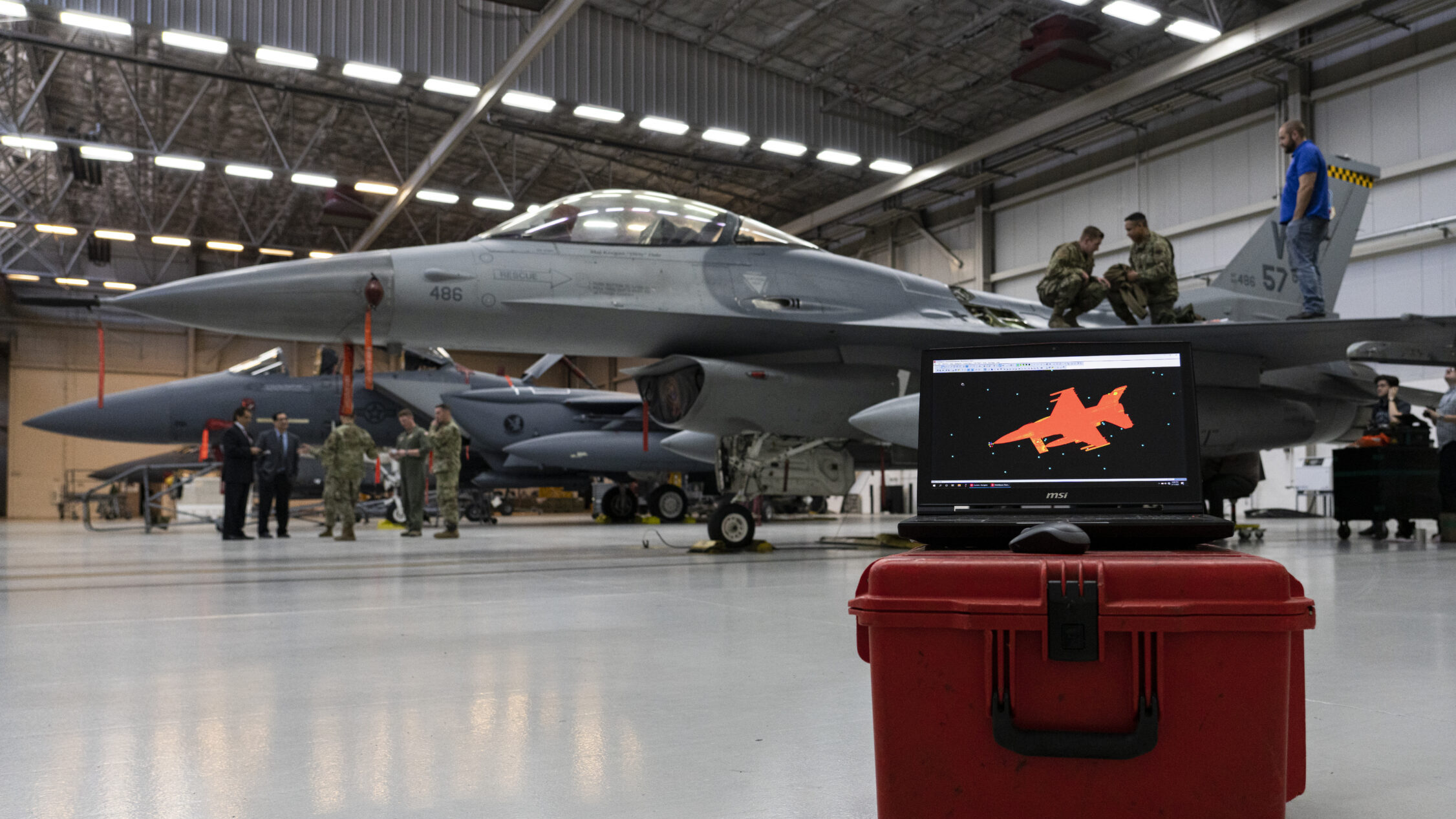
A completed 3-D scan of a F-16C Fighting Falcon is displayed on a screen at Nellis Air Force Base, Nevada, Feb. 11, 2020. (U.S. Air Force photo by Airman 1st Class Christopher H. Stolze)
AFA: A top Air Force officer for strategy and multi-domain operating concepts delivered a stark message today: “Time has run out for change. We can’t push this problem down the road. If we don’t change, we’re going to lose” in the future, Lt. Gen. S. Clinton Hinote told an audience at the Air Force Association’s 2021 Air, Space & Cyber conference.
Hinote, speaking on a panel with other Air Force officers, said, “There was a time when wargames were set in the future, and those weren’t going very well, but it was a future problem.” But now, he said, “I believe it’s a today problem. What would things look like if we went tonight?
“Not in all cases, but in more and more cases, we are at parity with our competitor. I don’t think that’s okay. I don’t think you think it’s okay. The [Air Force] secretary doesn’t think that’s okay,” he said, referencing an earlier speech at the conference. “If tomorrow’s warfighters fight the way we fought yesterday, we’re going to lose, and that’s not okay. We will not be able to protect our allies [in the Indo-Pacific] if we can’t project power in airspace. Right now, if we were to try to do it, we’d have to depend on a platform that would fail.”
So, what to do about it? Hinote said the Joint All Domain Command and Control (JADC2) concept is the way forward. “As a former wargamer, I don’t know how to win a future conflict without joint all domain operations,” Hinote said. “There’s never a silver bullet. There’s never a single technology… although JADC2 is [as] close” as anything.
In addition to developing the JADC2 capability, the Air Force has to look specifically at nuclear modernization, as well as “thinking differently” about vertical lift and intelligence, surveillance, and reconnaissance (ISR). Hinote said the Air Force is specifically thinking about future ISR as “a multi-sensing grid,” wherein all types of data are collected, transmitted, analyzed, and then used to make decisions.
But Hinote said there are challenges, increasingly in cyberspace. “What’s going to happen is [some adversary is] going to try to corrupt our database, and we’re going to try to corrupt theirs.”
Digital Acquisition ‘Is The Future’
Lt. Gen. Duke Richardson, a top official in Air Force acquisition on the panel, said today he views “winning” as having two meanings: the design and development of new aircraft and acquisition reform. Richardson oversees programs worth $60 billion annually in research and development, test, production, product support, and modernization.
As to acquisition reform, Richardson said that entails setting reasonable requirements, putting professionals in charge, and empowering those professionals. Richardson stressed that digital acquisition “is the future.”
Richardson also pleaded with the defense industrial base to “think beyond your own company. Think beyond quarterly earnings calls. [The Air Force] want[s] to compete on the merits of who has the best technical solution.”
This entails, in part, letting go of legacy systems, which “we’re wasting money on,” said the third panelist, Lt. Gen. David Nahom, who leads the development and integration of the Air Force resource allocation plan.
Nahom also talked at length about the “friction” between maintaining assets to support today’s operations with “tak[ing] risks on future capabilities,” stressing the need to “prioritize” correctly. Hinote reiterated this theme of risk-taking, adding, “Aversion to risk is what’s going to hurt us most.”
A related topic that got much discussion revolved around requirements for emerging technologies, especially in the acquisition cycle. Richardson noted the Air Force is “trying to be much more careful” about how it provides requirements, because some program requirements are “shockingly detailed, which is pretty constraining.”
But, as far as accelerating change, Richardson said, “Things are going take the time they’re going to take. We have to get it right to avoid going in the wrong direction.” He added sometimes you have to “go slow to go fast.”
An audience question noted that many of the emerging technologies often discussed will not be fully mature until the early 2030s, some estimate. So what happens if, for instance, China moves on Taiwan before then?
“I don’t know what China’s going to do,” Hinote said. “I don’t know if China knows what China’s going to do. It’s a threat and existential risk to them” to go after Taiwan.
So, until some of the much-discussed emerging technologies come online, Hinote said, “We’ve got to fight differently with what we’ve got.” And that means, in part, developing a “sense of thinking over time. It doesn’t do any good to win on day one if you lose [overall] on day three or day 33.”






















